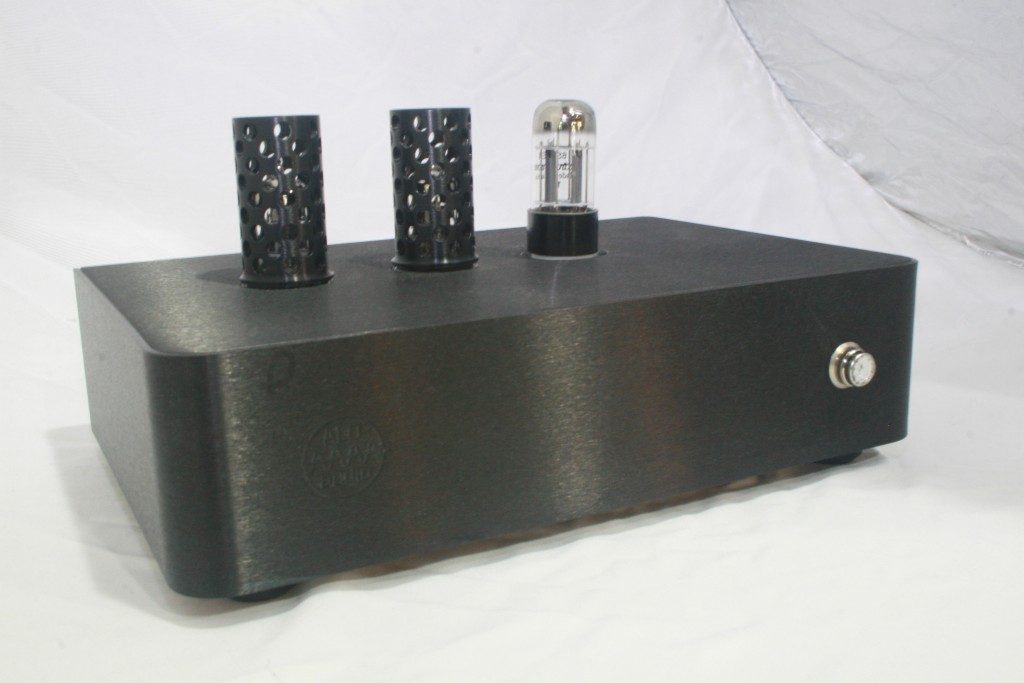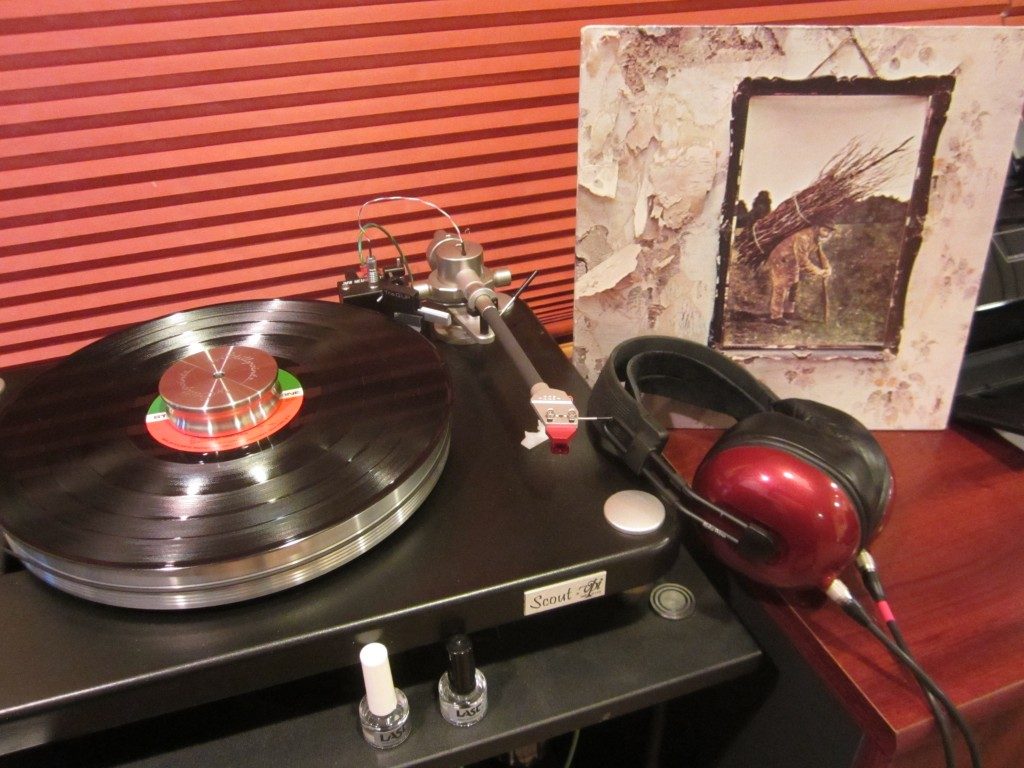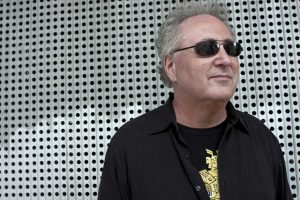Some reviews take awhile because you secretly do not want to let go of the gear. You look around for extra change and how to delay the car repair. The Studio Six and its companion Phono Stage are like that. As I wrap up this review I am still looking at the checkbook and working the wishful math around in my head.
I first spent some brief time with the Studio Six and Phono Stage from ALO Audio at RMAF last October. It was the debut for the Phono Stage and it was front and center of the ALO Audio booth at the Denver Tech center. The Phono Stage is powered off the Studio Six via an umbilical cable. Ken Ball from ALO Audio was showing the pair off like a proud parent.
The Studio Six headphone amplifier itself has been around for a couple of years. It is a result of a successful collaboration between ALO Audio, led by Ken Ball and engineer Thomas Martens. Ken’s goal was to create an end game tube headphone amp. The amp must be a master of that one goal. There are no pre-outs on the Studio Six. The amp has three pairs of RCA inputs, the connection for the umbilical to the Phono Stage and the power cord plug. (BTW, Ken sent along one of his top quality Green Line power cables to assist in the review! Thanks Ken!)

The Studio Six was designed from the ground up to be the best headphone amp they could build. Ken searched for someone who had great design knowledge and a personal goal of creating a top of the mountain amplifier. Thomas was that person. His marvelously over engineered result is the Studio Six, a headphone amplifier that can run four pairs of single ended headphones with no sacrifice in power and sound quality, even when driving power hungry Planar Magnetics headphones.
The Studio Six employs (L-R) one 6SN7 input tube, two 6V6 output tubes, two OB2 gas regulators and a 5AR4 rectifier. The Amp comes stock with tubes from JJ Electronics and GE, however ALO Audio’s website offers several choices of other tube options from JAN Phillips, Tung-Sol, Electro-Harmonix and others. I used additional tubes from Bendex (6V6’s), Philips (5R4GYS), Electro-Harmonix (6SN7), Jan Sylvania (OB2 WA and 6V6GT) and a United Electronics Company USAF-596. Tube rolling is highly recommended!

On the front of the Studio Six from L-R we see the Selector switch which switches between three RCA inputs and a fourth position for Mute. Next is the Volume control. Then we see the four Single Ended inputs. Pick one or all, they offer the same wonderful sonic experience. Finally we have the Power Indicator light.

The Phono Stage uses two 12AX7’s and one 6SN7. It supports most of todays Phono cartridges with three selectable input loads (0pf, 100pf and 200pf) supporting three stages of Class A Triode amplification per channel.

On the back we have (L-R ) the power connector for receiving power from the Studio Six, The Audio Output RCA’s going to the Studio Six (Or to a pre-amp of you want to use the system as a Phono Pre-amp only) the inputs from the turntable and the cartridge-loading switch.
After receiving the two ALO products I hooked them up following the instructions. (Yes, I read the manual! When you play with $6000 worth of headphone amps, you take your time!) Then I spent a few minutes on the ALO Audio website, www.aloaudio.com. The description on the Studio Six page caught my eye.
Reference Amplification
Class-A single-ended triode (SET) circuit design with zero-feedback and 100% tube amplification. Designed for resolution of fine musical details, expansive soundstage presentation, and lush tonal quality.”
Time to see if there is truth in advertising!
I did allow for some burn in time. After a week of anticipation I started with some digital audio via the MacBook Pro with Amarra 3.03 and my Wyred 4 Sound DAC-2 DSDse. The USB cable was the Light Harmonic 10G Red Split 2 Meter cable. Headphones are Sennheiser HD800’s using Toxic Cables Silver Widow SW25 cables, Audeze LCD-X with stock cables, MrSpeakers Alpha Primes with stock cables and AudioQuest NightHawk’s using their Solid Perfect-Surface Copper+cables. The NightHawks cable’s plugs use their thick Direct-Silver plating over extreme-purity copper base metal with the headphones.

First up is Donald Fagen’s I.G.Y from The Nightfly. (16/44.1 256bps MP3 from iTunes) I am a big fan of both Steely Dan and Donald Fagen’s solo efforts. The quality of the production is always top notch. Hooking up the HD800’s what first strikes me about the sound is the terrific sense of space. Each note has its place and it is placed perfectly. The solid bass line lends a foundation that moves the track along without being bloated or boomy. One of the things about the HD800’s I enjoy is that they are accurate to a fault. Given that revealing nature, many amps are exposed by the HD800’s for not delivering the sonic goods. The Studio Six brings it in classic form.
Compared to the same track played via my Simaudio Moon Neo 430HA amplifier the Studio six brings tube lushness to the sound. It leaves a bit of the directness of the Solid State Moon’s delivery in exchange for a more organic presentation. Bass is more pronounced with the Studio Six in a pleasing and bouncy manner. Both presentations are top shelf. You have to pick you favorite flavor.
Next up I picked out a long time vinyl favorite; Sheffield Labs #17. Tower of Power direct to disc and Squib Cakes. (LP. Recorded June 22-24, 1981 MGM Studios Culver City CA. )

Sheffield Labs discs are a rare treat these days. The immediacy of a live recording direct to disc is incredible. The Phono Stage grabbed hold of my Dynavector 10X5 with a velvet grip. The VPI Scout 1.1 paired beautifully with the ALO offering. The sound was basically 3D as I could see myself practically directing this incredibly talented band. The dynamics were huge as the group went through their set. The soundstage was perfectly revealed. Front to back depth illuminated the stage, keyboards were life like, and brass was brash and clear. Perhaps the best part was there was no smearing of the blended integration of the various instruments. Each was distinct and appropriate. Bright powerful NON-FATIGUING HD800 full and clear sound. Something only the very best amps can provide. HD800’s are ruthless for brightness with poor quality amps. Give them a clear signal and they reward with as real a performance as you can get. This was a revelation. The pairing of the Studio Six and the Phono Stage was as formidable a combination as I have heard from my VPI Scout 1.1 or my HD800’s. I listened to the whole album. This is what music enjoyment is about!
Next up was a new album by one of America’s best songwriters. James Taylor’s Before this World (LP 2015 Concord Music Group) 180 Gram virgin vinyl. For this I switched up to the Audeze LCD-X headphones. The X’s are my favorite open Planar Magnetic headphones. They offer a full and deep bass response and a more intimate experience than the HD800’s. Perfect for James Taylor’s style.

The piano on You and I Again had the natural touch you expect from great recordings. The gentle plucking of the strings from James’ guitar were crisp and the tone full. James Taylor is always in great voice so I spent the time just enjoying the song and not trying to pick it apart for the review. Visceral sound delivered with lush completeness. The song Angels of Fenway really pulls at the heartstrings of family and shared experience. The LCD-X’s delivered via the ALO Duo. Even with a more intimate performance you can still easily feel you are sitting at the front table in the club, favorite beverage in hand enjoying a special evening. Front row seats compliments of ALO Audio.
I put down the Audeze’s and picked up the MrSpeakers Alpha Prime closed Planar Magnetics. These are my closed reference headphones. The Alpha Prime’s have great energy and a slamming low end. What should I pair with them? How about an original release of Led Zeppelin IV? (LP Atlantic Records 1971 SD 7208)

Yes! Tubes are not just for chamber music! Black Dog with all the grit and power I enjoy. The vocals reverb echoes into the distance. Tight and driving bass line. Crisp drum hits. That moment when the tip of the drumstick hits the drumhead sounding just so and of course the soaring and screaming guitar work. This is what I remember from 1971 when the record came out and I bought this copy. Take that eBay!
Wrapping up the listening session I switched to my newest pair of headphones, the AudioQuest NightHawk (Review forthcoming on Headphone.guru) The NightHawks are AudioQuest’s first foray into the Headphone world and they have succeeded in creating a terrific value. The NightHawks have a pure and uncolored sonic signature that cried out for something orchestral with great vocals. So I put on one of my favorite Record Day discoveries, Linda Ronstadt and the Nelson Riddle Orchestra’s What’s New (LP 1983 Electra Records) What better way to finish the impressions of a musical triumph than with I’ve got a Crush on You.

I have the SACD for this album and I have enjoyed it for 30 years. The beauty of the vinyl is in the shear depth of the recording. The supportive mass of the stand up bass anchoring the orchestra was a perfect counterpoint to the incredible clarity of Linda’s voice. The muted coronet had the perfect brassy tone as the solo progressed, fading out as the massed strings took the lead. The effect was to place you once again at the front and center table of the smoky jazz club. Reservation for a party of one? Private table? Yes please! Come this way. The pairing of the Studio Six, Phono Stage and the NightHawks had me listening to the entire album. Do you like woodwinds? How about horns? Triangle? It was on the right just off center and about 15 feet back.
So what is the verdict on the ALO Audio Studio Six and Phono Stage? It is an audio triumph. You may find another amp you like as well but it is unlikely you will find one that is definitively better. This is a mountain top amplifier. It pairs well with Dynamic, Planar, Open, Closed and Semi-Open headphones. The Studio Six itself is the single best Headphone Amplifier I have ever heard paired with the Sennheiser HD800’s. Using the Phono Stage with vinyl is sublime. Paired with a high quality DAC like the Wyred 4 Sound DAC2 DSDse and digital comes through as natural and engaging.
So IS there truth in advertising? Yes!
So much truth that I scrounged even harder than usual and found the necessary coinage to buy the review samples. May I present my Tube Headphone Reference amplifier, The ALO Audio Studio Six.
Pros
The Studio Six is consciously overbuilt and should pass to the next generation.
The Studio Six and Phono Stage offer terrific tube rolling options.
Wonderfully full and lush sound without being too Tube” sweet.
Reference quality with all compatible headphones. Particularly well paired with the HD800’s.
Three friends can join you for a high end listening party!
The Phono Stage can pair with the majority of Cartridges.
Both the Phono Stage and the Studio Six had a very black background and low noise floor. No hiss was present.
Cons
Specifically designed for headphone use only. No Pre-amp functionality.
The Phono Stage requires the Studio Six as a power source if you choose to use it with a Pre-Amp.
Tech Specs:
Studio Six MSRP $3900.00 USD
Headphone impedance compatibility range:
8 Ohms to 600 Ohms
Maximum rated output power:
1,000 milliwatts into 8 to 32 Ohms
Amplifier input impedance:
95k-Ohms
Amplifier input Voltage for full-rated output voltage into various headphone impedances:
1.00V RMS input for 4.0V RMS output into 16 Ohms
1.30V RMS input for 5.7V RMS output into 32 Ohms
1.70V RMS input for 7.5V RMS output into 75 Ohms
1.85V RMS input for 8.3V RMS output into 150 Ohms
1.70V RMS input for 8.2V RMS output into 300 Ohms
1.65V RMS input for 8.1V RMS output into 600 Ohms
THD+N (1kHz input) at 1V RMS output into stated load impedances:
32 Ohms: 0.26%
150 Ohms: 0.12%
THD+N (1kHz input) at 250 milliwatts output into stated impedances:
32 Ohms: 1.0%
150 Ohms: 2.0%
Frequency Response -3dB (Referenced to 1kHz, 250 milliwatts output) into stated impedances:
32 Ohms: 6.0Hz to 39kHz
150 Ohms: 16.5Hz to 36kHz
Frequency Response -1dB at full-rated (2.83V RMS) 1,000 milliwatt output into 8 Ohms:
15Hz to 20kHz
S/N Ratio:
78dB (unweighted) below full 2.83V RMS output into 8 Ohms
Tech Specs:
Phono Stage MSRP $1849.00 USD
Tube Compliment: 12ax7 (x2), 6SN7
3 stages of Class A Triode amplification per channel
Passive RIAA equalization
Zero Feedback circuit design
Independent channel multi stage power supply filtering.
Supports cartridges of 1 – 10mv output. Suitable for both Moving Magnet and High Output Moving Coil cartridges.
3 position input load switch to suit your cartridge requirements.
Related Gear
Moon Neo 430HA ( www.simaudio.com )
Wyred 4 Sound DAC2 DSDse ( www.wyred4sound.com )
LH Labs Pulse Infinity ( www.lhlabs.com )
Denon DVD-5900 ( www.usa.denon.com )
VPI Scout 1.1 with Dynavector 10X5 ( www.vpiindustries.com )
Cambridge Audio 651P Solid State Phono Pre ( www.cambridgeaudio.com )
ALO Audio Phono Pre ( www.aloaudio.com )
Sennheiser HD800’s ( www.sennheiser.com )
Toxic Cables Silver Widow SW25 headphone cables (www.toxic.co.uk )
Audeze LCD-X ( www.audeze.com )
MrSpeakers Alpha Prime (www.mrspeakers.com )
AudioQuest NightHawk Headphones nighthawk.audioquest.com
ALO Audio Green Line power cable
Stillpoints Ultra SS (www.stillpoints.us )
Stillpoints Ultra 6
Stillpoints LPI Long Spindle record weight
Light Harmonic 10G Red USB Cable (www.lightharmonic.com )
Amarra 3.03 ( www.sonicstudio.com )
Audirvana+ (https://audirvana.com )















Reply
Reply
Want to join discussion?
Feel free to contribute!